Cut car use
There are lots of things that towns can do to help people make the switch to more sustainable ways of getting around. These pages show that more and more Scottish towns are doing good things for the rest of us to learn from, and there is more funding and advice available than ever before.
This section is not about banning cars from our town centres – and indeed many people, like some with physical disabilities for example, might not have a choice of transport option. However the convenient size of many Scottish towns means that far more of us could get around without a car if only it were safer and easier, to the benefit of both our wellbeing and the environment.
Check out the examples below, and links to resources at the bottom of the page.
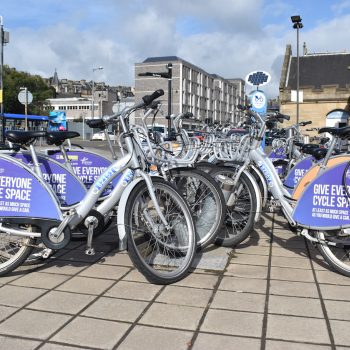
Encourage walking and cycling: Stirling Active Travel Hub
Stirling’s Active Travel Hub is in the town centre, right at the railway station and bus stops – a handy central location where you can get your bike checked, learn how to fix a puncture, plan a route, try an ebike, borrow a cargo bike and much more.
The hub has an equally prominent online presence
with news about the local bike hire scheme, events calendar and lots of information about other initiatives like their Employer Engagement programme.
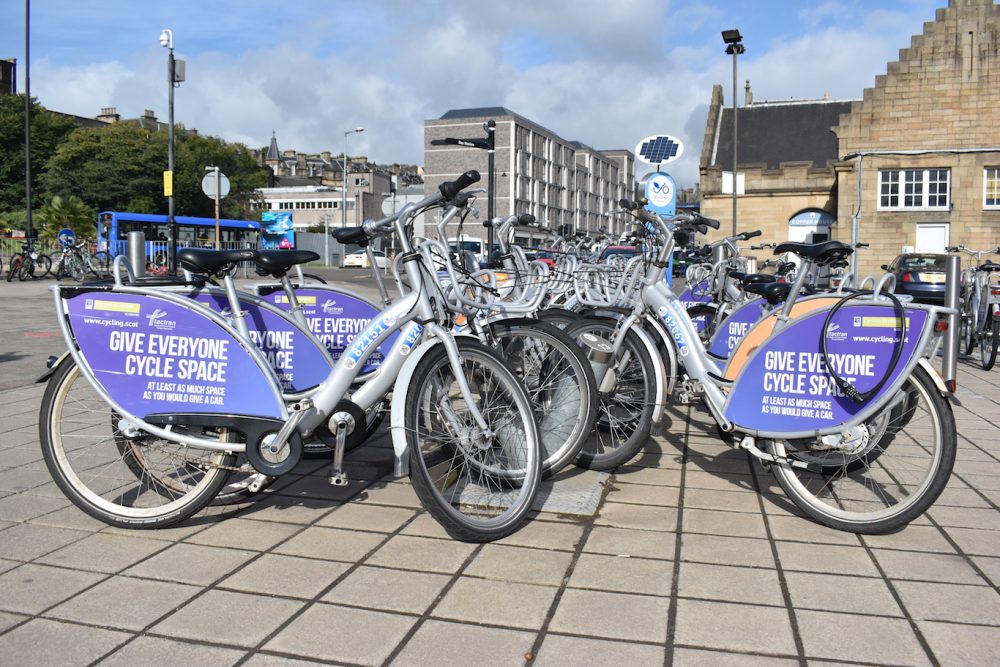
Stirling has become a bit of a bike town, with a number of town centre bike shops and cycling clubs, Forth eBike Hire with bike hire stations from Stirling to Falkirk, and Recyke-a-Bike for recycling pre-loved bikes and learning how to do bike maintenance.
There are similar town centre Active Travel Hubs in Ayr, Falkirk, Kilmarnock and elsewhere, all working to get more people walking and cycling for local journeys. The network was established by Transport Scotland.
Go low-carbon: Huntly Travel Hub
Since 2015, Huntly Travel Hub has been helping the community find alternative travel options to private cars. The initiative has lots of strands. Two of the most popular are, firstly, the Co-Wheels car club, which rents out new electric/hybrid vehicles to local residents by the hour, bookable online. Secondly, a fleet of e-bikes, great for people who are recovering from illness or find cycling too much of a challenge. There’s been a fantastic uptake – with people saving money, getting fitter and reducing carbon emissions.
The Travel Hub is run by Huntly Development Trust; visit their website for the story of how they went about it. You can contact them directly via email: hdt@huntly.net. Funding came from the Climate Challenge Fund and Paths for All’s Smarter Choices, Smarter Places fund.
Check out Smarter Choices, Smarter Places success stories for inspiration from other towns around Scotland.
For more information on Huntly, check out the Inspiration section.
Beat the Street: Annan and Stranraer
Beat The Street turns towns into giant games to improve community cohesion, health and increase active travel. The programme does this by making it easy to build walking and cycling into daily life. In Scotland, Beat the Street has been played in 14 locations by over 122,000 residents – towns include East Kilbride, Annan, Stranraer, Lanark, Rutherglen and many others.
Beat the Street gets a community moving together, leaving long-term health benefits and impact on air quality and active travel. The programme uses advanced smartcard and online technology to run a town-wide competition that captures imagination and interest. People play in school, community and workplace teams and can win prizes for themselves and charity. Participants record their distance walked by tapping their Beat the Street game cards on set locations called Beat Boxes placed on lamp posts at various locations, watching their total distance accumulate creating competition and fostering a love of exercise. Residents are then supported to remain connected and active via local programmes.
The message to residents is simple: Earn points, win prizes and discover more about your area by walking, running and cycling. Pick up a Beat the Street card and tap Beat Boxes across your community!
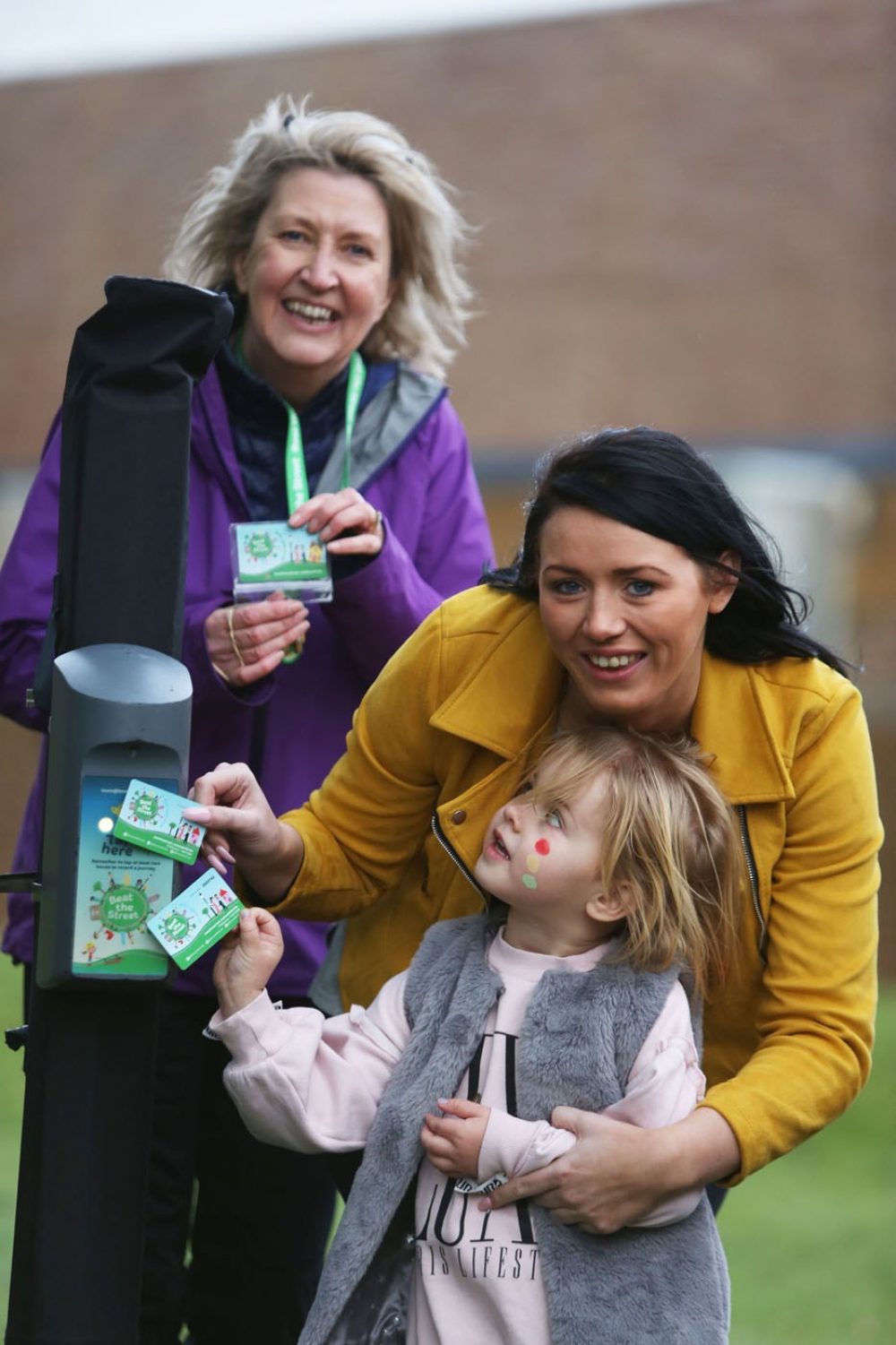
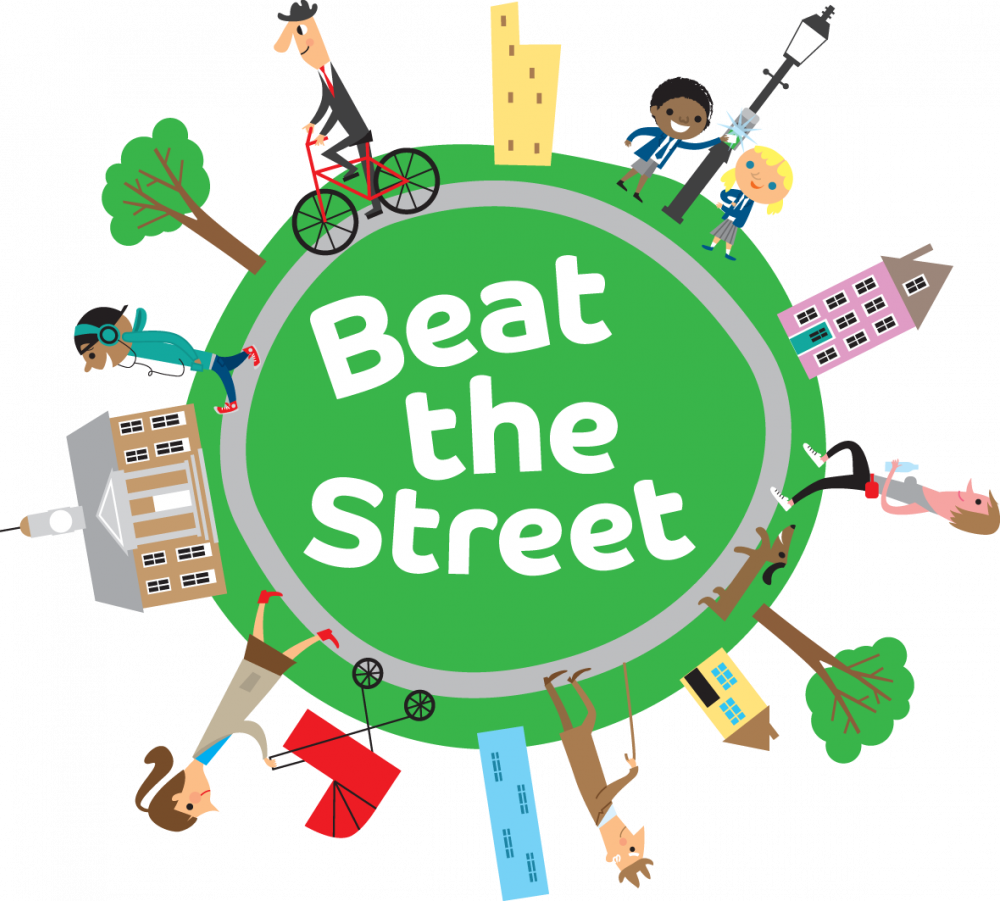
What are the positive impacts?
Beat the Street games in Annan, Dalbeattie and Stranraer each lasted six weeks. In Annan, over 3,000 people took part – 39% of the local population. Of those surveyed afterwards, nine out of ten thought that Beat the Street helped them be more active (94%), feel healthier (94%), walk more than usual (90%) and feel more involved in their community (85%). Half said Beat the Street helped them take the car less (56%). At the start of Beat the Street 28% of people cycled at least once per week. By the end this had increased to 42%.
Stranraer was also a huge success, with again nearly 40 per cent of the town's population participating, including 35 workplace teams, 22 schools and many individuals signing up to play. Positive outcomes included an increase from 62% to 82% of participants meeting the government physical activity target for adults.
It all proves that boosting walking and cycling can be easy, quick and fun – and engaging for communities!
For more information about what was achieved in the towns, click here and here. If you’d like to play Beat the Street in your town, contact Craig.Mcgarrie@intelligenthealth.co.uk
Saddle Up Clackmannan
Over the years, Clackmannanshire Council and Walk Wheel Cycle (formerly Sustrans) have built plenty of cycling and walking infrastructure in and around Clackmannan… what was missing was encouraging local people to use it. So, Clackmannan Community Development Trust has been leading a programme of cycle training, rides and maintenance courses to encourage locals back in the saddle again (or for the first time). The council, local schools and Sustrans have all lent their support. It’s a good example of building on infrastructure investment to help people change their behaviours.
As the video explains, it’s a lot easier for community organisations like a development trust to access funding to do this kind of thing. Saddle Up Clackmannan is just one of many projects that the local development trust is leading.
Create a walking and cycling network: Arbroath Active Travel Network
Angus Cycle Hub, a social enterprise which supports and develops cycling in Angus as well as running a bike shop in Arbroath, wanted to find out what people needed to encourage more cycling. Local research revealed that people felt there were no real safe places for cycling directly into the centre of Arbroath.
So, the Cycle Hub team went out and cycled and walked the local area to get a better understanding of the barriers that people faced. That led to a successful application to Paths for All's Communities Active Travel Fund, which is supported by Transport Scotland.
The result was the Arbroath Active Travel Network - a signposted circular route around the town using footpaths, cycle paths and quiet roads. It means that Arbroath's residents and visitors can now easily make local walking and cycling journeys.
Delivering this project successfully has also been a stepping stone to achieving more: the next ambition, which emerged through community engagement in a town centre “charrette” in 2016, is to redesign the dual carriageway that runs through the heart of the town, cutting the town centre in two. Sustrans’ Places for Excellence funding and support programme is helping to take the project forward.
For more information, contact Angus Cycle Hub by email: info@anguscyclehub.co.uk.
Redesign your streets: Poynton Regenerated
Poynton town centre sits astride a busy main road between Macclesfield and Stockport, south of Manchester, with 26,000 vehicles passing through every day (2012 figures), including a significant number of heavy goods vehicles. The road acted as a barrier through the middle of the town centre. Simply adjusting traffic signal timings had failed to improve traffic congestion through the town centre. Something different needed to be done.
This radical project reconfigured the road junction in the town centre, first on a temporary basis and then permanently. The traffic lights were replaced by two roundabouts that are level with the street surface and defined by paving patterns of varying colours and textures. Vehicles negotiate the roundabouts without the guidance of traffic signs or white lines. There are informal pedestrian crossings. Compared to before, there are wider footways and less space for vehicles.
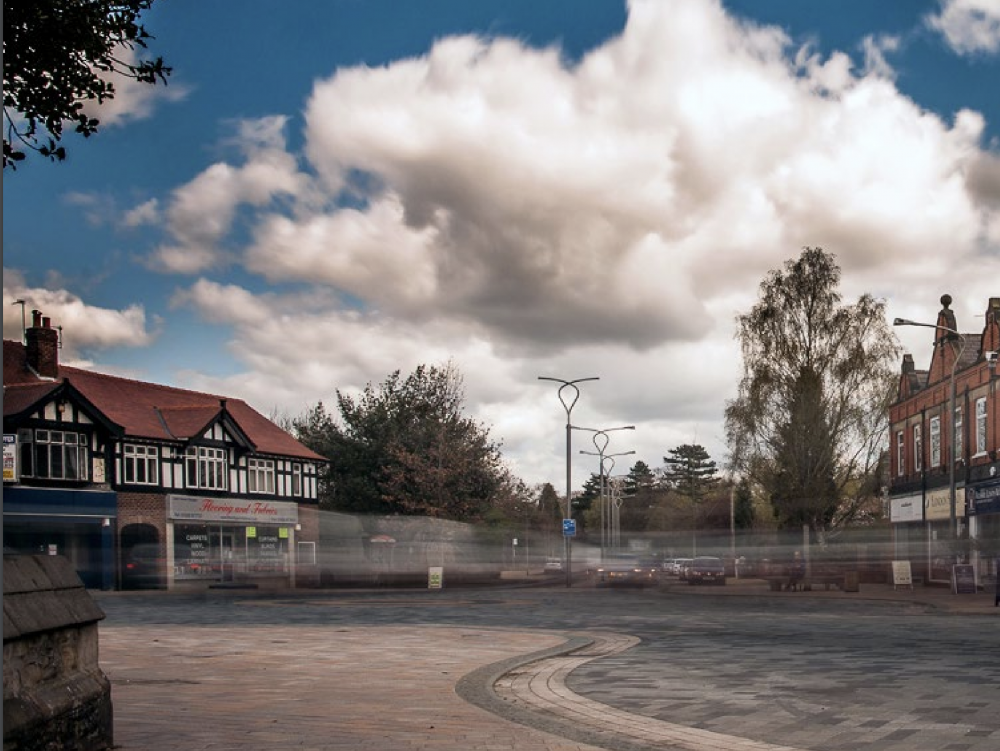
Despite initial scepticism, the scheme has delivered the following measurable benefits:
- One minor accident in the first three years of operation, compared to several serious incidents each year before that.
- Average traffic speeds have fallen to a more people-friendly 20 mph, but journey times through Poynton have significantly reduced and pedestrian delays in the town centre have dropped.
- 80% of town centre retailers report increased footfall and turnover.
The scheme isn’t perfect – for example, details like the absence of facilities for disabled people and dedicated cycle lanes have been criticised. But it shows what can be achieved with strong leadership.
Check out the Resources section below for more information on how to go about redesigning your streets.
Resources for cutting car use
Walkipedia brings together information and evidence relating to walking, pedestrians, and active travel in Scotland. It provides quick access to relevant legislation, policies, strategies, guidance, research websites and statistics as well as to relevant organisations, detailing their programmes, initiatives and relevant toolkits.
Paths for All promote walking and cycling for everyday short journeys in Scotland, including providing funding. Their website has a large bank of success stories from around the country.
Sustrans' showcase has more examples of projects that encourage sustainable travel in towns around Scotland.
The original Scottish Government Town Centre Toolkit (2015) contains lots of information and examples about how streets and spaces can be designed to make them more attractive for walking and cycling.
Living Streets promotes walking as a mode of transport; their website contains information, advice and examples, including their Walking Connects guide for communities about better streets and pavements.
Way to Work contains links to a wide range of funding, tools, information and advice for Scottish employers and employees on walking, cycling, e-bikes, electric vehicles, car sharing and public transport.
TravelKnowHow Scotland is an online resource offering easy access to a variety of travel planning solutions.
CoMoUK
(Co-Mobility UK) supports the UK’s transition to integrated mobility solutions, including car clubs, ride sharing and bike sharing, plus emerging modes including mobility hubs, on-demand buses and scooter sharing. Their website contains information and examples.